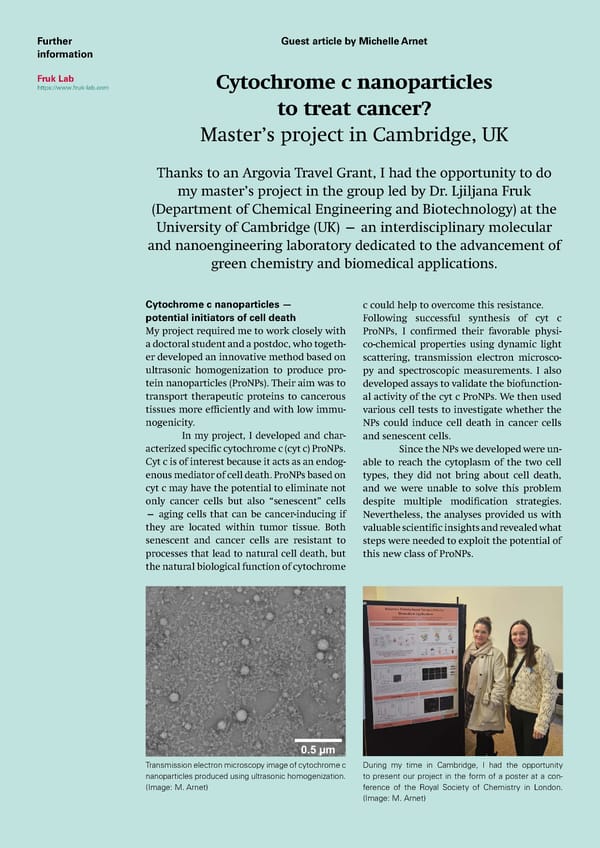Further Guest article by Michelle Arnet information Fruk Lab Cytochrome c nanoparticles https://www.fruk-lab.com to treat cancer? Master’s project in Cambridge, UK Thanks to an Argovia Travel Grant, I had the opportunity to do my master’s project in the group led by Dr. Ljiljana Fruk (Department of Chemical Engineering and Biotechnology) at the University of Cambridge (UK) — an interdisciplinary molecular and nanoengineering laboratory dedicated to the advancement of green chemistry and biomedical applications. Cytochrome c nanoparticles — c could help to overcome this resistance. potential initiators of cell death Following successful synthesis of cyt c My project required me to work closely with ProNPs, I con昀椀rmed their favorable physi- a doctoral student and a postdoc, who togeth- co-chemical properties using dynamic light er developed an innovative method based on scattering, transmission electron microsco- ultrasonic homogenization to produce pro- py and spectroscopic measurements. I also tein nanoparticles (ProNPs). Their aim was to developed assays to validate the biofunction- transport therapeutic proteins to cancerous al activity of the cyt c ProNPs. We then used tissues more e昀케ciently and with low immu- various cell tests to investigate whether the nogenicity. NPs could induce cell death in cancer cells In my project, I developed and char- and senescent cells. acterized speci昀椀c cytochrome c (cyt c) ProNPs. Since the NPs we developed were un- Cyt c is of interest because it acts as an endog- able to reach the cytoplasm of the two cell enous mediator of cell death. ProNPs based on types, they did not bring about cell death, cyt c may have the potential to eliminate not and we were unable to solve this problem only cancer cells but also “senescent” cells despite multiple modi昀椀cation strategies. — aging cells that can be cancer-inducing if Nevertheless, the analyses provided us with they are located within tumor tissue. Both valuable scienti昀椀c insights and revealed what senescent and cancer cells are resistant to steps were needed to exploit the potential of processes that lead to natural cell death, but this new class of ProNPs. the natural biological function of cytochrome Transmission electron microscopy image of cytochrome c During my time in Cambridge, I had the opportunity nanoparticles produced using ultrasonic homogenization. to present our project in the form of a poster at a con- (Image: M. Arnet) ference of the Royal Society of Chemistry in London. (Image: M. Arnet) SNI INSight June 2024 17
 SNI INSight June 2024 Page 16 Page 18
SNI INSight June 2024 Page 16 Page 18